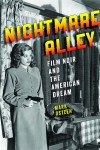Tropical Storm Andrea’s pouring rain here in Baltimore and throughout much of the mid-Atlantic and Northeast today, but we know the summer reading and movie-going season is just about upon us. Before you hit the theaters or crack into that stack of crime and noir novels, we suggest you take some time to consider the art, roots, and culture of these beloved bits of brain candy. Here are four books that’ll make you think before the sun bakes your brain:
 John T. Irwin’s Unless the Threat of Death is Behind Them: Hard-Boiled Fiction and Film Noir is perhaps the perfect entrée into the tensions, conflicts, and motivations roiling beneath the surface of the modern crime and noir genres. An engrossing read, the book digs deep into the development of early twentieth-century detective fiction to explain what books such as The Maltese Falcon and movies like Murder, My Sweet teach us about ourselves, our evolving society, and, ultimately, our own fears.
John T. Irwin’s Unless the Threat of Death is Behind Them: Hard-Boiled Fiction and Film Noir is perhaps the perfect entrée into the tensions, conflicts, and motivations roiling beneath the surface of the modern crime and noir genres. An engrossing read, the book digs deep into the development of early twentieth-century detective fiction to explain what books such as The Maltese Falcon and movies like Murder, My Sweet teach us about ourselves, our evolving society, and, ultimately, our own fears.
 Blackout: World War II and the Origins of Film Noir, by Sheri Chinen Biesen, looks at the effects of World War II on film noir, focusing on how Pearl Harbor forced a sharp cultural transformation in America that made horror, shock, and violence not only palatable but preferable to filmmakers and audiences alike. A challenge to conventional film scholarship, Biesen’s book uses such films as The Big Sleep, Double Indemnity, and The Stranger on the Third Floor to show how political, social, and material conditions during the war transformed Hollywood.
Blackout: World War II and the Origins of Film Noir, by Sheri Chinen Biesen, looks at the effects of World War II on film noir, focusing on how Pearl Harbor forced a sharp cultural transformation in America that made horror, shock, and violence not only palatable but preferable to filmmakers and audiences alike. A challenge to conventional film scholarship, Biesen’s book uses such films as The Big Sleep, Double Indemnity, and The Stranger on the Third Floor to show how political, social, and material conditions during the war transformed Hollywood.
 Our recently published Nightmare Alley: Film Noir and the American Dream, by Mark Osteen, picks up on the themes explored in Blackout by examining how such classic films as They Live by Night, No Man of Her Own, and Somewhere in the Night treated the American Dream. Osteen, an English professor and founder of the Film Studies Program at Loyola University Maryland, explains how, in the wake of World War II, early film noir challenged, refuted, and even subverted the very American ideas of self-reinvention, individualism, and upward mobility.
Our recently published Nightmare Alley: Film Noir and the American Dream, by Mark Osteen, picks up on the themes explored in Blackout by examining how such classic films as They Live by Night, No Man of Her Own, and Somewhere in the Night treated the American Dream. Osteen, an English professor and founder of the Film Studies Program at Loyola University Maryland, explains how, in the wake of World War II, early film noir challenged, refuted, and even subverted the very American ideas of self-reinvention, individualism, and upward mobility.
 Though it’s still a couple of months before Charles J. Rzepka’s Being Cool: The Work of Elmore Leonard will come off press, we’d be remiss not to note this lively insider’s look at the celebrated crime fiction writer’s work. Leonard’s artful and highly stylized depictions of dope dealers, bookies, grifters, financial advisers, hookers, crooked cops, and other nefarious underworld figures is itself instructive. But Rzepka, who spent hours interviewing Leonard, gives us even more meat, explaining how the author’s style developed and evolved and probing the limits of the “Leonard sound.” The book uses jazz terminology to delineate the stages, styles, and patterns that characterize Leonard’s creative evolution.
Though it’s still a couple of months before Charles J. Rzepka’s Being Cool: The Work of Elmore Leonard will come off press, we’d be remiss not to note this lively insider’s look at the celebrated crime fiction writer’s work. Leonard’s artful and highly stylized depictions of dope dealers, bookies, grifters, financial advisers, hookers, crooked cops, and other nefarious underworld figures is itself instructive. But Rzepka, who spent hours interviewing Leonard, gives us even more meat, explaining how the author’s style developed and evolved and probing the limits of the “Leonard sound.” The book uses jazz terminology to delineate the stages, styles, and patterns that characterize Leonard’s creative evolution.

